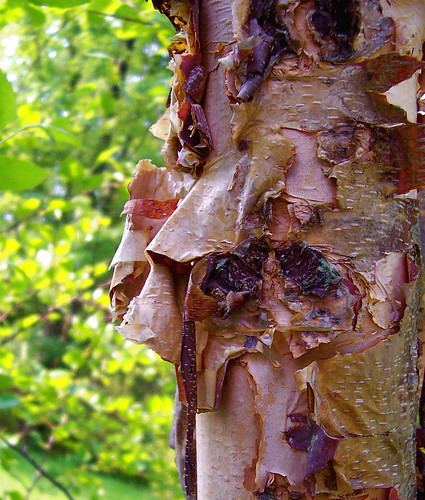Many people see birch trees as weak trees, associating them with the slender white trunks that come crashing down beneath the dominant oak in succession or the ornamental trees that look pretty but so often have to be cut down after pest infestation. But the river birch (betula nigra) is resistant to most pests and diseases. Unlike many other trees, river birches can survive in standing water, and their roots can penetrate a heavy clay soil. Their flexible trunks handle strong winds and heavy ice.
River birches are survivors. In April, the river birch in my back yard was flattened almost to the ground by heavy snow. Many of the scotch pines in my woods came crashing down during that storm, the brittle trunks breaking under the weight of the snow. But the river birch was unharmed. When the snow melted, the flexible limbs and trunk of the river birch simply sprung back into place.
On hot August days, the green leaves of the river birch are edged with gold, and in fall, the leaves turn bright yellow. The leaves don't stay on the tree very long after turning colour; if you live close to a river birch, you get just a glimpse of the beautiful colour before the leaves fall to the ground.
As a river birch matures, the bark shreds and peels away from the trunk, which makes the tree look battered and scarred, and yet somehow beautiful. Ironically, the rough edges of the curling reddish bark, contrasting with the vulnerable pink smoothness underneath, are what make the tree so attractive. In winter, the lovely shredding trunks and red-brown twigs of the river birch provide colour to a bleak February landscape.
In spring time, the green leaves of the river birch sway in the wind and offer a dappled shifting shade. A river birch might grow three to five feet in one spring. More than anything, this is a tree known for rapid growth, its branches bending and reaching toward sky.


13 comments:
Sounds like the perfect tree to plant.
I grew up with birches, but they are not indigenous to where I live now. I MISS them. Their resilience inspires me.
I love birch trees.
I grew up in a house that was surrounded by white birches-they're among my favorites-but I've never seen a river birch. What the bark does is lovely.
That bark reminds me of snakeskin. cool.
PPB: I suppose that's why, for me, both snakes and river birches are symbols of growth, change, and transformation. It's cool to think of shedding skin or bark ....
Are they clump-forming? I associate them with tepees because there's a line in Mona in the Promised Land about Seth cutting down his stepmother's river birches for tepee poles (the irony being that the cause-embracing, bourgeois stepmother does more good in the world than the weakly anti-establishment stepson.)
Well, I'm sold. I gotta have one...
S: Yes, they grow in clumps, so instead of one trunk, they might have three or four.
The trunks of the young trees are strong and flexible so I think they would make good poles.
I have always loved birches--how wonderful to read a tribute to them!
Looking back over the past half dozen or so of your posts, I must say that I just love your photos. They are fabulous.
The river birches around here all went bye-bye after the MLK-weekend ice storm, those that had not come down during the bad windstorms last summer. The were NOT resilient to high winds or heavy ice, at least not at the 15 - 25-year-old stage of most of them around here. (And yes, I do know the diff between river and white birch.) Ours looks like an inverted cone now b/c the main trunk was lost. Most people lost so much of their trees / clumps that they took them out.
The river birch is a native of the swamplands of North Carolina, according to all the sites and info I can find. All I know is that it sheds leaves like a so-n-so the minute it gets the slightest bit dry in the summer here, too. I will give it props for growing in the modelling-clay we call soil around here.
I did take some of the already-peeled-off bark and make some pretty decorator balls to go in a bowl in my family room...
What a gorgeously evocative photo. When I was small, at camp in the Northwoods, our camp director (whom we worshipped) used to teach us about not caving in to the temptation to peel the dangling bark from the birch trees by asking us, "How would you like it if someone came up and peeled off a strip of your skin?" Unusually macabre for summer camp, the image stuck with me and made me smile every summer, into my counselor days. I've associated a kind of stoic toughness with birches of all kinds ever since.
And hey, thanks for the link!
Post a Comment